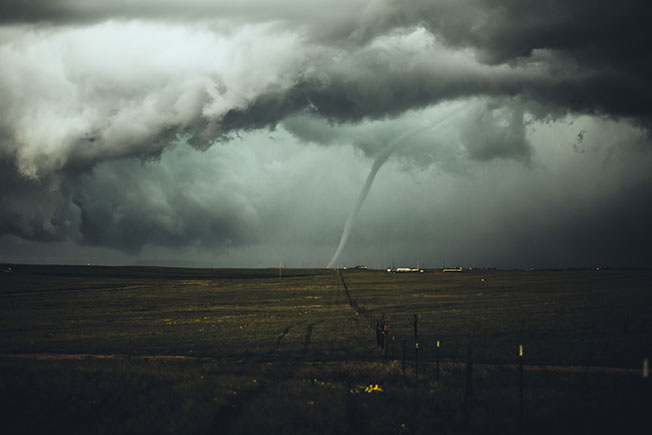What Canadian Homeowners Can Learn from the Barrie Tornado

On July 15, 2021, the city of Barrie was struck by an EF-2 tornado, with winds as high as 210 km/h. Ten people were injured, though luckily there were no life-threatening injuries. However, the tornado damaged roughly 150 homes, and approximately 60 were hit so badly that local officials deemed them unsafe to enter. It’s expected that at least 100 people have been displaced until their homes can be repaired.
The Barrie tornadoes are a good reminder that natural disasters can happen almost anywhere in Canada. Although Southern Ontario may not experience the kinds of wildfires that can cause extensive damage in Western Canada or up north, the region is no stranger to wind storms, tornadoes, and other extreme weather. Tornadoes are also known to happen across the country, and extreme weather is a significant risk factor just about everywhere in Canada.
In the wake of the Barrie tornado, you may be wondering what to do when a wind storm damages your home. Let’s take a look at some of the questions homeowners have and some of the issues that can come up when you make a claim for wind storm damage.
Is Tornado Damage Covered by Insurance?
Most home insurance policies in Canada cover wind storm damage by default. That coverage includes structural damage, lost personal belongings, and living expenses incurred if your home is uninhabitable. You should review your insurance policy if you remain unsure about the perils it covers.
It’s also important to remember that home insurance policies will have a limit to how much you can claim and a deductible. The deductible is how much you have to pay before the insurer will contribute. In cases where your home has only experienced light damage, such as damage to part of your gutter system, a high deductible may mean you end up paying for most of the repairs anyway.
If you’re looking for home insurance claims advice, these are the steps you should take to prepare for your claim:
- Keep damaged property unless it’s a health hazard until the insurance adjuster can see it.
- Photograph all damage whether it needs to be removed or not.
- Gather all receipts and proof of payment for any property lost or damaged.
- Begin creating a list of damaged or lost property.
- Keep your receipts for clean-up costs and, if your home has become unlivable, keep receipts for any living expenses (such as accommodations or food) incurred during the recovery period.
The damages and costs will be reviewed by an independent insurance adjuster hired by the insurance company or one who is directly employed by the insurer.
What Happens If Your Car Is Damaged in a Wind Storm?
Wind storms can do more than damage your home. High winds have the potential to bring down heavy tree branches or even entire trees. In older neighbourhoods with more mature trees, that can be a hazard to anyone out on the street during the storm, as well all the cars parked in driveways or on the side of the road.
If your parked car has been damaged by debris in a wind storm, it won’t be covered by your home insurance. However, it may be covered if you have comprehensive car insurance coverage. This is coverage that protects you from damage or loss that is not the result of a road accident.
Check the Declaration Pages of your auto insurance policy to find out if you have comprehensive coverage. You can also call your insurance agent or review a detailed copy of your policy.
What Happens If Your Home Isn’t Up to Code?
In the aftermath of the Barrie tornado, researchers with the Northern Tornado Project found during inspections that some of the houses may not have been up to code. They reported signs that some of the houses did not have adequate roof-to-wall connections, as evidenced by the fact that on some houses, the walls were ripped out before the roofs and shingles. Typically, shingles are the first to fail, and the roof usually fails before the walls.
What happens if your home is damaged in a natural disaster, but there is evidence that your home wasn’t up to code? Building codes are put in place to prevent unnecessary damage. Sometimes a wind storm is too powerful, and there is no avoiding damage, but in this case, inadequate construction may have led to preventable damage.
The additional damage means that some of the damaged houses may be condemned. This means that they cannot be repaired but will have to be demolished and completely rebuilt. Those homeowners will face bigger house insurance claims and may even reach the limits of their policies.
Should You Update Your Home Insurance After a Storm?
A wind storm can be an important wake-up call when it comes to your insurance policy. It’s easy to forget about the details of your policy until something happens. If your home is only mildly damaged or your neighbours were hit harder than you were, it can be a good opportunity to review your insurance and make adjustments. By updating your insurance after a storm, you can make sure that you’re fully covered should anything more significant happen down the road.
In cases like the Barrie tornado, where a home must be rebuilt from the ground up, you may also want to adjust your insurance when the renewal period comes up. In a total loss, the process can easily take over a year between the time you start the recovery process and the day that you move back in.
If the timing aligns, you may be able to save on your premiums by adjusting your insurance to only cover what remains on the property. In the event of a total loss, you may be able to reduce your coverage to reflect the reality on the ground. You can talk to your insurance agent about making those adjustments. Ensure that you reinstate your policy immediately after your home has been repaired or rebuilt.
Wind storms and tornadoes are commonly covered by home insurance policies in Canada, but if the recent news has you anxious about your coverage, it never hurts to review your policy. Be sure to check your coverage limits, deductibles, and insured perils.


